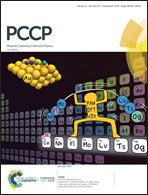Sandwich-type Na6B7− and Na8B7+ clusters: charge-transfer complexes, four-fold π/σ aromaticity, and dynamic fluxionality†
Abstract
Boron-based clusters possess unusual structural and bonding properties owing to boron's electron-deficiency. We report on the theoretical prediction of two binary B–Na clusters, Na6B7− and Na8B7+, which assume unique sandwich geometries, featuring a perfectly planar B7 wheel and two triangular Na3 or quasi-tetrahedral Na4 ligands. Despite distinct electronegativities of B/Na, the B–Na clusters do not form typical salts. Both sandwich species are dynamically fluxional at 300 K and beyond. Two dynamic modes are observed: an in-plane rotation of the B7 wheel versus twisting of the two Na3/Na4 ligands. Their energy barriers are negligibly small. Natural bond orbital calculations show that the clusters are charge-transfer complexes [Na3]+[B7]3−[Na3]+ and [Na4]2+[B7]3−[Na4]2+, respectively. Chemical bonding analyses indicate that the B7 wheel in the clusters has 6π/6σ double aromaticity and the Na3/Na4 ligands are 2σ aromatic, collectively leading to four-fold π/σ aromaticity. The quasi-tetrahedral Na4 ligand is the simplest example of spherical aromaticity and can also be considered a superatom. Interlayer bonding in the sandwiches is greater than 20 eV, due to electrostatics, which should not be confused with weakly bound species. Four-fold π/σ aromaticity and robust interlayer ionic bonding offer uniform and dilute electron clouds over the sandwiches, facilitating their dual-mode dynamic fluxionality. The Na8B7+ cluster is also a superalkali cation.



 Please wait while we load your content...
Please wait while we load your content...